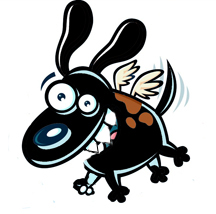 Dog flies a nuisance to both humans and pets from August to November
Dog flies a nuisance to both humans and pets from August to November
When fall approaches those refreshing weather fronts will move through from the north bringing lower humidity, lower temperatures and the infamous dog fly. The stable fly (Stomoxys calcitrans), known as the dog fly in Northwest Florida, is a blood feeding fly that is a nuisance to man, pets, and livestock.
From August through November the dog fly congregates on the Florida Panhandle beaches. This fly originates from farming areas in southern Alabama, Mississippi, Georgia and northern Florida and rides the northerly winds associated with cold fronts that move through our area.
Stable or dog flies look like house flies in size and color. The dog fly, however, has a long piercing mouth-part to penetrate the skin and obtain blood, the house fly does not. Both sexes of the dog fly feed on blood, usually twice a day. The life cycle is egg to larva to pupa to adult, complete metamorphosis. The female lays 500 – 600 eggs in her lifetime, they hatch in 2 to 3 days, feeds in the larval stage for 2 to 4 weeks, then into the pupal stage where it transforms into an adult in 1 to 4 weeks. Adults live for 2 to 3 weeks, depending on weather conditions. Adults can be carried by winds up to 150 miles from where they were born and can be produced in Florida year-round because of our mild climate.
Their eggs are laid on decaying, wet, organic matter such as manure, rotting grain, silage or a mixture of such, usually found around livestock or dairy farms, hence the name, stable fly. The adults feed on the legs and bellies of cattle and horses and also dog’s ears, hence the name dog fly. This fly prefers animals and feeds on man only if there are no animals around. Dog flies are inactive at night, resting in vegetation. As the sun rises and warms things up, the flies become active, primarily using sight to find its host.
A difficult solution
The most practical and economical method for controlling stable/dog flies is to eliminate their larval habitat. Decaying, wet organic matter (manure or compost piles) must be spread out and dried, maggots cannot develop in dry materials. If this is not feasible the rotting material can be covered with black polyethylene plastic and allowed to compost. The plastic cover excludes the flies from laying their eggs. Natural predators such as chickens and parasitic wasps destroy many flies while in their larval stage. Once they reach the adult stage, sticky traps, fly strips, chemical pesticides and repellents are our only defense.
Information courtesy South Walton Mosquito Control District
